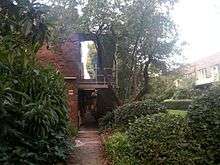Best Overend
Acheson Best Overend (15 October 1909 – 1977) was an Australian architect. His notable works were an important contribution to modernist architecture in Melbourne, Australia.
Early life
Overend was born in Launceston, Tasmania on 15 October 1909. He was the son of Harold Acheson Overend, a Methodist minister and Emily Trahair, a businesswoman. The only son, with 5 sisters, Best studied at Wesley College, Melbourne.
In 1926 Best became an articled pupil in the practice of architect H. Vivian Taylor, who was an expert in acoustics and specialized in the design of theatres and broadcasting stations. During this time, Best worked on the additions of Station 2AY Broadcasting Studio in Albury, 1930, the remodelling of the Crown theatre for HO Peterson Esq. and a project for the then-known Independent House, Melbourne.
Overend was educated in architecture at Swinburne Technical College and the University of Melbourne Architectural Atelier later during the evenings.
Career
Overend went to London in 1931. Raymond McGrath was the first person whom Overend first worked for during his arrival in London. Overend worked with McGrath for a few months before Overend left the office in July 1931 when he moved to a different company. His new employer was ‘Wonderful Wells’ (Wells Coates).
Overend worked under Wells Coates as chief draftsman for over eighteen months. He got a chance to participate in the documentation of the interiors of Broadcasting House, the new headquarters of the British Broadcasting Corporation.
Overend passed his RIBA examinations in 1932 and joined the Architectural Association. In September 1931 he received a job offer from Serge Chermayeff (whose office adjoined McGrath’s) to do the drawings and calculations for a house which he designed on his own. Wells later rejected the offer on behalf for Best as he refused to let Best work under Chermayeff as his subordinate.
Practice in Melbourne
Overend returned to Melbourne in March 1933. He was then offered a partnership with H. Vivian Taylor and G. A. Soilleux, architects of 499 Little Collins Street in May. It was only shortly after he was elected as an Associate of the RVIA. The firm which is now known as 'Messrs H. Vivian Taylor, Soilleux and Overend' specialized in cinema design.[1] Some of their prominent works include interiors for the Windsor Theatre, Albert Street, Windsor, 1936 and the Padua Theatre, Brunswick in 1937. Other commissions include service stations in Carlton and in Flinders Street at Queens Bridge in 1933.
In May 1938, Overend opened his own firm and his projects were mainly residential before World War II began.
Achievements
- Published in The Argus
- Published in the Home Beautiful, an art magazine from Geelong entitled Manuscripts
- Published in Table Talk
- Awarded Prize-Winning Nursery Design in 1930
- Writer for the column, "Architecture and Property" in The Argus
- One of four architects on the Architects Panel of the Housing Commission of Victoria from 1938 to 1955
Military service
Overend served in the Royal Australian Air Force in World War II. He rose to the rank of Squadron Leader and was mentioned in dispatches.[2]
Notable works
Armytage House
One of Overend's first works in his partnership was the design of the Armytage House, Mont Albert Road, Balwyn, 1933. It is published in the Australian Home Beautiful magazine. It talked about the simplicity of materials, and how this principle determined the form and finish of this house both internally and externally . The staircase was one of the main features of the building. Within the stair hall, it is unsupported circle concrete that went up without any landings from the ground floor to the first floor.
Cairo Flats

In December 1935, Overend was asked to design 40 stand-alone flats in Nicholson Street, North Fitzroy. He proposed 2 different types of design – one with a single main room and the other with separate living and sleeping space. They include shops, communal dining rooms and even living spaces for the house manager. The Cairo Flats were planned as a U-shaped block around a garden. They face north and east for views. Balconies were placed on the south and west face of the walls. The building was completed in December 1936. It had a total of 28 living spaces and 8 storage rooms.
Koornong School
Overend designed the school at Warrandyte, Victoria in 1939.[3] He used exposed framing with stained boards and paintings from the teachers. Most of the schools' buildings were destroyed by bushfires in the 1950s.[3]
House in North Balwyn
Another of Overends' projects for a house was built on a hillside in 1939. It is located in North Balwyn. The house was 2 stories high, and is a rectangular prism. It is made from brick, cement sheets, steel, and timbers. Each area inside was separated by a sliding curtain.
References
- ↑ "Architecture & Property: New Theatres" (digitised). The Argus. National Library of Australia-Trove (nla.gov.au). 9 November 1933. p. 11. Retrieved 1 May 2014.
- ↑ "Acheson Best Overend". Honours and Awards. Australian War Memorial (Awm.gov.au). 7 March 1946. Retrieved 1 May 2014.
- 1 2 "Former Headmaster's House And Adjacent In-ground Water Tank At Koornong Experimental School, End Koornong Crescent (West)". Victorian Heritage Database. Vhd.heritage.vic.gov.au. Retrieved 1 May 2014.
- Goad, Philip (1995). "Best Overend – Pioneer Modernist in Melbourne". Fabrications. 6 (1). doi:10.1080/10331867.1995.10525089.